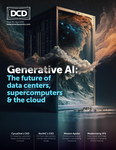The growth of AI, such as ChatGPT and PaLM, is undoubtedly bringing with it changing approaches to data control and management.
AI will generate heavy volumes of data, some of it latency sensitive. This means big bandwidth and big pipes must be as close as possible to the users. AI-produced high-definition live-streamed video or cars communicating with the cloud or sensors – such use cases will need to guarantee almost instant connectivity.
But the mind-boggling number crunching of high-performance computers training AI models cannot be built and operated everywhere. But they don’t need to be. Beyond the training, when the AI has absolved its education and is ready to be put to use, I am convinced that we will see significant levels of localization – and I’m not talking about a few algorithms on an Edge device, but fully-fledged AI models – to meet local market needs in low latency.
AI will also affect how enterprises think about multiple clouds. A lot of AI training and processing will happen in a particular cloud. However, many other applications that feed data to the AI model or use data from the AI model may well be housed in other clouds. Therefore, ensuring interoperability between clouds and low latency cloud-to-cloud communication becomes essential for operating a cohesive AI-enabling multi-cloud strategy.
Here, cloud concentration risk mitigation plans will become a factor in developing a multi-cloud strategy. Whatever happens, enterprises using AI from the cloud need the best connectivity between the given cloud and the enterprise infrastructure to access networks that serve their customers.
AI requires high performance, resilience, security, and compliance management in real-time. Data center operators can’t just be about servers, power, cooling, and space. This is not where the value is created today.
As AI becomes more critical to company processes, direct interconnection is a plus for performance and security, allowing shorter pathways, lower latency, higher bandwidth, and control over data flows. It’s also important to avoid the public Internet for data protection considerations, where customer data is involved.
A multi-cloud or hybrid-cloud scenario also needs excellent connectivity between clouds to enable AI. Again, connectivity to clouds must be separated from the public Internet. It must be secured and direct.
To create the environment AI and enterprises need in terms of infrastructure, every single data center operator today needs to have a solution for an interconnection platform that is as close to seamless as possible.
Established data-center neutral interconnection hubs can offer this. They can, in fact, offer the market a highly distributed platform where all the relevant data centers are enabled in one integrated ecosystem. This is not only an advantage because diverse data center operators are included in one ecosystem, but such a distributed ecosystem offers enterprises much greater resilience and flexibility in their connectivity.
A geographically distributed cloud exchange, available in multiple data centers across one or more metro regions, combined with a strategy for ensuring redundant connectivity, provides the greatest level of resilience for company data and processes in the cloud – including AI-fuelled interactive infotainment systems in modern vehicles, AI-powered analytics for the optimization of processes in the production plant, or chatbots for customer service and sales support. This makes it possible to ensure the continuous availability of internal and customer-facing services or apps.
Established data-center-neutral interconnection hubs are a good starting point for data centers seeking customer interconnection services. New hubs will likely spring up based on localization, cloudification, and cloud infrastructure.
We will see that where these hubs become established, further data center investments will follow. With new and established locations interconnected through strategic partnerships and infrastructure sharing, there will be highly distributed interconnection infrastructure across the planet.
The benefits of AI are still being understood. But more hubs will support them. And with more hubs will come further digital infrastructure investments along the entire value chain, driving the development of high-quality digital services enabled by AI, along with affordability and performance. The AI-driven digital data journey is just beginning.






